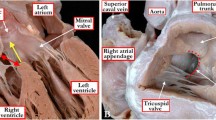Abstract
Previously proposed formulae for the quantitative estimation of bidirectional shunts across ventricular septal defects require determination of the oxygen contents of mixed venous, pulmonary artery, pulmonary venous, and aortic blood. Because these formulae do not take into account the mixing of oxygenated with unoxygenated blood within the ventricles, their use must result in underestimation of shunt flows in each direction. A mathematical model for a ventricular defect is examined, in which it is assumed that mixing of blood occurs in each of six sites in the venae cavae or right atrium, right ventricle, pulmonary artery, left atrium, left ventricle, and aorta. A total of fourteen streams of blood can flow from one to another of these mixing sites. As long as complete mixing occurs in the six specified mixing sites, any degree of mixing or non-mixing of the various streams is permitted. From the equations characterizing the model, formulae are derived in which the shunt flow in each direction is expressed in terms of the oxygen contents in the six mixing sites and the fractions of blood which enter the shunt from either side without prior mixing in a ventricular mixing site. The previously reported formulae, which apply when no ventricular mixing is allowed to occur, lead to theoretical minimum values for the shunt flows in each direction. At the opposite extreme where all the shunting blood is required to mix in a ventricle before entering the shunt, formulae for maximum possible shunt flows are also obtained. The absolute values for the left-to-right and right-to-left shunt flows, which must lie somewhere between the theoretical maximum and minimum values, cannot be computed from blood gas data alone.
Similar content being viewed by others
Literature
Barratt-Boyes, B. G. and E. H. Wood. 1957. “The Oxygen Saturation of Blood in the Venae Cavae, Right-Heart Chambers, and Pulmonary Vessels of Healthy Subjects.”American Heart Journal,50, 93.
Dexter, L., F. W. Haynes, C. S. Burwell, E. C. Eppinger, R. E. Siebel, and J. M. Evans. 1947. “Studies of Congenital Heart Disease. I. Techniques of Catheterization as a Diagnostic Procedure”.Journal of Clinical Investigation,26, 547.
Gorlin, R. L. 1959. In Zimmermann:Intravascular Catheterization, Chapter IV. Springfield, Illinois: Charles C. Thomas.
Grayzel, J. and A. G. Jameson. 1963. “Optimum Criteria for the Diagnosis of Ventricular Septal Defect from Measurements of Blood Oxygen Saturation.”Circulation,12, 64.
Levin, A. R., J. P. Boineau, M. S. Spach, R. V. Canent, M. P. Capp, and P. W. Anderson. 1966. “Ventricular Pressure-Flow Dynamics in Tetralogy of Fallot.”Circulation. To be published.
Rudolph, A. M. and G. G. Cayler. 1958. “Cardiac Catheterization in Children.”Pediatric Clinics of North America,5, 907.
Author information
Authors and Affiliations
Additional information
This work was supported in part by grant HE-07563 from the National Heart Institute of the National Institutes of Health and grants-in-aid from the American and North Carolina Heart Associations and the Life Insurance Medical Research Fund.
Work completed during tenure as U.S.P.H.S. post-doctoral fellow.
Rights and permissions
About this article
Cite this article
Thompson, H.K., Peter, R.H. & McIntosh, H.D. Ventricular septal defect with bidirectional shunting: Mathematical considerations. Bulletin of Mathematical Biophysics 28, 167–179 (1966). https://doi.org/10.1007/BF02476991
Received:
Issue Date:
DOI: https://doi.org/10.1007/BF02476991




